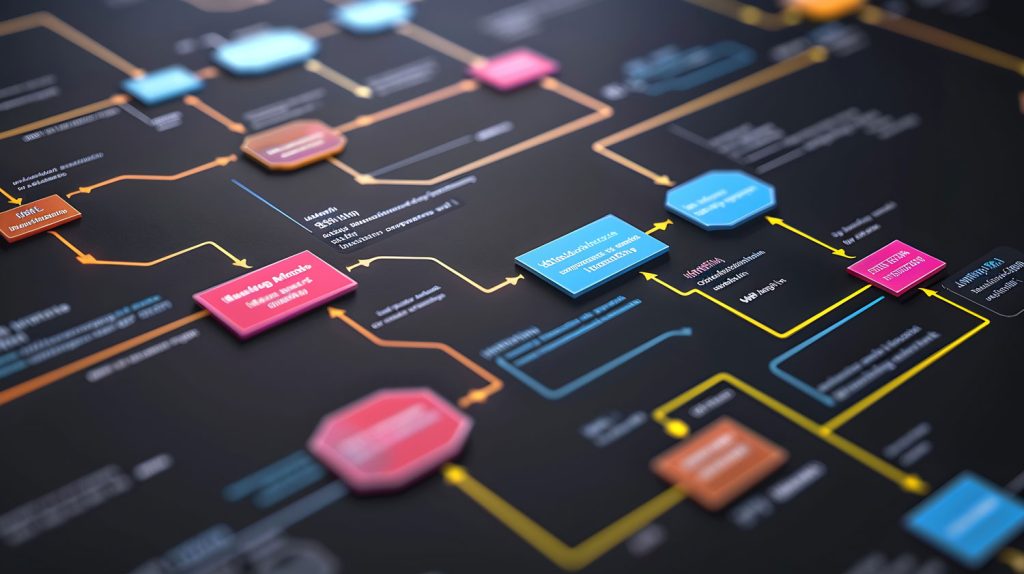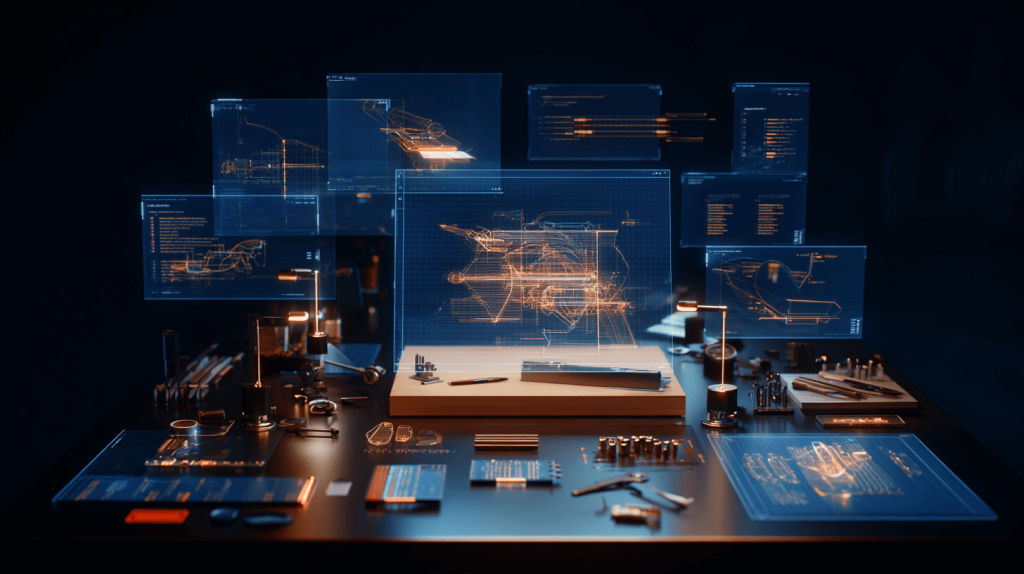Are AI agents patentable? This question often arises when teams develop proprietary Artificial Intelligence (AI) or Machine Learning (ML) platforms utilizing AI Agents to streamline operations. If you’re wondering about the patentability of your AI agent or ML platform, the short answer is yes, if properly claimed and well articulated in a patent application.
To begin with, your invention must have a human inventor and meet the strict statutory patent requirements to ensure it’s novel, non-obvious, and useful. This article will guide you through the complexities of patenting AI agents and help you protect and monetize your AI/ML technology.
As you know AI technology has expanded dramatically leading to increased interest in protecting and monetizing these proprietary software solutions. AI agents, which are specialized AI powered tools capable of performing tasks autonomously or semi-automously are already used in multiple industries including healthcare, finance, education, retail, and supply chain management.
As these intelligent software solutions continue to revolutionize industries and execute multiple tasks simultaneously they will not only improve efficiency and enhance decision-making but simultaneously learn and adapt. With the right patent protections in place you can not only protect your invention from competitors by monetizing them through licensing and acquisition.
Key Takeaways
- AI agents, distinct from traditional rule-based systems, operate autonomously and are designed to improve over time without reprogramming.
- AI Agents are patentable subject matter if properly claimed and meet the statutory requirements for patentability.
- As the AI landscape continues to evolve the importance of protecting and monetizing your software solution is key to maintaining a competitive advantage.
Understanding Patent Protections for Your AI Agent
In the evolving landscape of artificial intelligence, recognizing the novelty and functionality of your AI platform is crucial for establishing a strong protective barrier against competitors. A clear understanding of the fundamental requirements for securing a patent is essential to effectively safeguard and monetize your AI/ML software solution.
Defining AI Agents
AI agents are autonomous or semi-autonomous software entities that have the ability to perceive their environment, process information, and complete tasks. Unlike traditional systems that often rely on predefined rules, AI agents have the capacity to process data and execute tasks, using the data they have gathered from sensors, APIs, and their interactive experiences to continuously improve and make future predictions.
This capability enables them to function autonomously across a variety of industries to analyze data, recognize complex patterns, and automate decision-making.
Incorporating multiple AI agents into enterprise-level applications can enhance productivity by performing multiple tasks simultaneously. In addition to increasing operational efficiency, these AI agents minimize mistakes, optimize solutions, and allow your team to focus on higher-value work.
Are AI Agents Patentable? Basics of Patentability
The foundation of the U.S. patent system is rooted in Article I, Section 8 of the U.S. Constitution, known as the “Intellectual Property Clause.” This provision is designed to promote innovation and technological advancement by granting inventors exclusive rights to their creations.
To obtain a patent for an AI invention, the invention must meet statutory requirements for patentable subject matter, including being novel, non-obvious to someone skilled in the field, and having practical applications. The United States Patent and Trademark Office (USPTO) carefully examines all non-provisional patent applications to ensure compliance with these requirements and to determine whether an invention is too “abstract” to qualify for patent protection.
When filing a patent application, inventors must clearly define the point of novelty and fully disclose both the enablement and best mode of practicing the invention. The best mode requirement ensures that the most effective way of implementing the invention is disclosed, preventing inventors from withholding superior methods while still securing a patent. Understanding these foundational principles is essential for anyone seeking patent protection for AI inventions.
Patent Eligibility for AI Agents
The legal landscape constituting what is considered patentable subject matter with AI agents and ML innovation is complex. AI and software inventions must fulfill established patent requirements while also tackling unique concerns related to AI/ML technology. Detailing the technical aspects of an AI model, such as its architecture, data pipelines, and interaction with hardware, is crucial in patent applications to distinguish the invention from known prior art and prevent a 35 U.S.C. § 101 “abstract” rejection.
There has been over a 150% increase in AI/ML implemented patent applications filed with the USPTO since 2021. This surge in AI patent application filings highlights the importance of protecting your AI and ML solutions in a hyper-competitive marketplace. Those companies that can identify and protect their AI-driven solution will not only build a “defensive moat” around their intellectual property but will derive a competitive edge.
Legal Framework for Patenting AI Related Innovations
In order for your AI or ML Agent to be patentable it must meet certain statutory criteria including:
- Novelty.
- Non-obviousness.
- Usefulness.
- It can’t be disclosed in the public domain for more than one year.
The novelty requirement under 35 U.S.C. § 102 necessitates that your invention is not already publicly disclosed or known before the effective filing date. Remember, if you’re still working on your AI/ML innovation you should consider filing a provisional patent application or keep your work a trade secret.
Non-obvious is another key requirement under 35 U.S.C. § 103 and is designed to ensure that only true innovations receive patent protections. “Non-obvious” means that your invention must not be an obvious improvement or modification of existing tech to a person “having ordinary skill in the art.” However, keep in mind that even if all the elements of your invention are found in the prior art, if their combination creates an unexpected result or significant improvement over prior solutions it may be patentable.
Usefulness is required under 35 U.S.C. § 101 and designed to grant patents only to those inventions that have practical applications rather than “abstract” ideas or theoretical concepts. Remember, your invention must fit within the four eligible categories of processes (methods), machines, manufacture (physical goods) or compositions of matter to be patentable subject matter.
What Can Be Patented in AI?
AI/ML-based inventions can be patented, but eligibility depends on demonstrating a concrete technical improvement rather than an abstract idea. The USPTO recognizes patents for innovations that enhance AI performance, such as novel machine learning models, improved data processing techniques, or new ways of integrating AI into real-world applications.
Patentable AI advancements must go beyond standard algorithmic functions by solving a specific technical problem, increasing efficiency, or improving accuracy. As AI technology evolves, staying informed about the latest patent guidelines is essential for securing strong intellectual property protection.
Practical Applications and Examples of AI Patents
AI-powered innovations have led to numerous granted AI patents across industries. Notable examples include:
- Tesla’s Autopilot System
Tesla has patented key technologies behind its Autopilot and Full Self-Driving system, which leverages vision-based AI and neural networks to process sensory inputs and perceive the environment to make autonomous driving decisions when controlling the vehicle through intersection, roundabouts and urban driving. These innovations enhance vehicle safety and efficiency, showcasing AI’s transformative role in the automotive industry.
- Airbnb’s Predictive Modeling System
Airbnb holds a patent for a machine learning-based system that predicts the likelihood of booking a property by analyzing user-specific data, such as browsing history and past bookings using factors such as location, dynamic pricing optimization, guest reviews, and host responsiveness. This predictive algorithm improves reservation forecasting while preventing suspicious activity and fraud.
- Generative AI in Medical Imaging
Patents have been granted for Generative Adversarial Networks (GANs) to improve the accuracy and efficiency of medical imaging. These GANS, Variational Autoencoders, and Diffusion Models systems generate high-quality synthetic images that assist in diagnosis, automate medical workflow and data generation for future training.
- Bank of America’s AI Innovations
Bank of America has secured over 1,100 patents related to artificial intelligence and machine learning, including systems for fraud detection, personalized financial services, and operational efficiency improvements. This highlights the financial sector’s growing reliance on AI technologies.
- IBM’s Generative AI Patents
IBM leads in generative AI patents, covering innovations in large language models (LLMs) and media generation tools. These patents include methods to improve scalability and content quality, with applications ranging from natural language processing to creative industries.
Example of an AI Patent Claim and Drawing
Below is the first independent claim and initial drawing figure from a registered patent owned by Google, LLC, titled “Allocating Resources for a Machine Learning Model.”
“The invention claimed is :
A computer-implemented method for allocating resources for a machine learning model, the method comprising:
“receiving a machine learning model to execute on a special purpose machine learning model processor; generating, from the machine learning model, a computational dataflow graph representing the machine learning model comprising a plurality of nodes, a plurality of connector directed edges, and a plurality of parameter directed edges,
wherein each node represents a respective operation performed by the machine learning model as part of the model output from the model input, wherein each connector directed edge connects a respective first node to a respective second node that represents an operation that receives, as input, an output of an operation represented by the respective first node, and wherein each parameter directed edge connects into a respective node and represents a flow of one or more parameters of the model as input to the operation represented by the respective node;
scheduling operations of the computational dataflow graph;
compiling the computational dataflow graph using a deterministic instruction set architecture that specifies functionality of a special purpose machine learning model processor;
determining an amount of resources required to execute the computational dataflow graph representing the machine learning model;
and allocating resources based on the determined amounts of resources required to execute the machine learning model represented by the computational dataflow graph.”
This claim provides an excellent example of how AI-related inventions must be precisely described to establish novelty and non-obviousness. The claim effectively outlines the specific technical steps involved in allocating resources for a machine learning model, going beyond a generic description of AI processes. By detailing the novel aspects such as computational dataflow graphs, deterministic instruction set architectures, and resource allocation techniques, the claim distinguishes the invention from existing technologies, which is crucial for overcoming prior art challenges.
The novelty of an AI patent claim often lies in its implementation—how the model operates, processes data, or improves efficiency. Without clearly defining these elements, the USPTO may reject the claim as overly abstract or lacking a significant inventive step. Additionally, well-drafted claims provide stronger legal protection, preventing competitors from designing around the patent while ensuring enforceability in litigation or licensing. This underscores the importance of balancing technical specificity with broad enough protection to cover potential variations of the invention.
See the first drawing figure from the same patent as the claim above, which visually represents the system and processes involved in allocating resources for executing a machine learning model. This figure illustrates how the processing system (100) receives a machine learning model (111) and systematically determines the necessary computational resources before execution on a special purpose machine learning model processor (117).
As described in the independent claim, the system first processes the machine learning model using a rewriter engine (101) and scheduling engine (103) to generate a computational dataflow graph, which structures the model’s operations. The compiler (105) then translates these operations into a deterministic instruction set architecture, ensuring compatibility with the specialized hardware.
A crucial aspect of the claim—determining and allocating resources—is carried out by the determination engine (107) and allocation engine (109), which work together to optimize execution efficiency. The allocation of resources (115) ensures that the model is properly distributed across the available computational infrastructure.
This diagram reinforces the novelty outlined in the claim by demonstrating a structured, methodical approach to resource allocation. The use of a computational dataflow graph with directed edges ensures that dependencies between operations are maintained, while the deterministic scheduling and allocation process optimizes the execution of machine learning models on specialized processors.
Overcoming Challenges in Patenting AI Agents
Securing patents for AI agents presents unique challenges, particularly in identifying the novelty and inventive aspects of software-based implementations. Successful patenting requires balancing legal precision with technical accuracy. Here are key considerations when drafting an AI/ML patent application:
- Clearly define the AI agent’s purpose, scope, inputs, outcomes, and behavior.
- Explain how the model is trained, optimized, and implemented.
- Identify the specific point of novelty in the implementation.
The claim set is the foundation of your patent application, as it defines the legal scope of protection if granted. Drafting claims requires strategic precision—claims that are too narrow may allow competitors to design around them, while overly broad claims risk repeated rejection by the USPTO due to existing prior art.
Given the rapid evolution of AI and ML technologies, conducting a thorough prior art search before filing is essential. Not only is this the most cost-effective approach, but it also provides a clear “snapshot” of the existing patent landscape, helping to refine your application and strengthen its chances of approval.
The Patent Application Process for AI Inventions
The patent application process for AI/ML-based inventions involves several steps and key considerations:
- Determine the type of patent protection: Typically, utility patents are used for AI inventions covering new processes, machines, or compositions of matter. Design patents may be used to protect a novel graphical user interface.
- Conduct a prior art search: It’s crucial to perform a prior art search to confirm the invention is novel and non-obvious by identifying any prior patents or similar innovations and understand how broadly you can draft the claim set.
- Prepare the patent application: The application must include a thorough and detailed description of the invention, explaining its functionality, how it works, and what makes it novel. Additionally, include drawings or diagrams that illustrate key components and processes.
- File the patent application: Submit the application to the USPTO, ensuring all forms and fees are completed. The USPTO will assign a patent examiner to review the submission.
- Wait for the USPTO to review the applications: The typical pendency time (I.e., wait time) for non-provisional patent applications is between 17-20 months. However, track one prioritized examination requests and petitions to make special are available under certain circumstances.
By following these steps, inventors can increase their chances of obtaining patent protection for AI technologies while avoiding common pitfalls that could lead to rejection.
Protect Your AI Intellectual Property, Backed By The RLG Guarantee
At The Rapacke Law Group, we stand behind our work with money-back guarantees on all prior art searches and provisional patent applications.
- Prior Art Searches: If our team determines that your AI agent is not likely patentable over the prior art, you will receive a full refund. If your AI solution is deemed patentable, we will credit the full cost of the search toward your patent application.
- Provisional Patent Applications: We are so confident in our ability to secure your priority filing date that we guarantee your provisional application will be accepted by the USPTO. If it is not, you get your money back.
This ensures that you can pursue patent protection with confidence, knowing that your investment is backed by our commitment to quality and success.
Impact on Innovation
Changes in patent law will significantly impact AI innovation, especially in fields like pharmaceuticals and supply chain optimization. Companies must stay informed on legal developments to secure intellectual property and maintain a competitive advantage.
Navigating AI Patents: Partnering with an Experienced AI Patent Attorney
Securing a patent for AI/ML agents requires a deep understanding of both AI technology and evolving patent eligibility requirements. Partnering with an experienced AI patent attorney ensures your application is strategically structured to meet legal requirements, maximize protection, and minimize the risk of rejection or litigation.
Not all patent attorneys have the technical expertise needed to navigate the complexities of AI innovation. At Rapacke Law Group, we combine deep industry knowledge with a fixed-fee billing approach—eliminating surprise costs and streamlining the process. Plus, our money-back guarantee on prior art searches, trademark applications, and design patent applications provides added peace of mind.
Taking the first step in protecting your AI innovation is simple. Schedule a free IP strategy call with our team today—we’ll help you navigate the patenting process and safeguard your intellectual property.
Common Questions
Can AI inventions be patented?
Yes, AI-related inventions can be patented, but only if a natural person is listed as the inventor. The USPTO requires that a human must have made a significant contribution to the inventive process, as AI itself cannot be legally recognized as an inventor. This ensures that patents remain tied to human ingenuity.
Who owns AI-generated intellectual property?
If an AI system creates a work without meaningful human involvement, that work is not eligible for copyright protection and falls into the public domain. Since current U.S. copyright law only grants protection to human authors, the U.S. Copyright Office will not register fully AI-generated works.
Is C3 AI awarded a patent for AI agents?
C3 AI has been awarded a U.S. patent for its advanced AI agent generative AI technology, showcasing its dedication to innovation in the field of generative AI. This patent underscores C3 AI’s leadership in the enterprise AI software industry.




